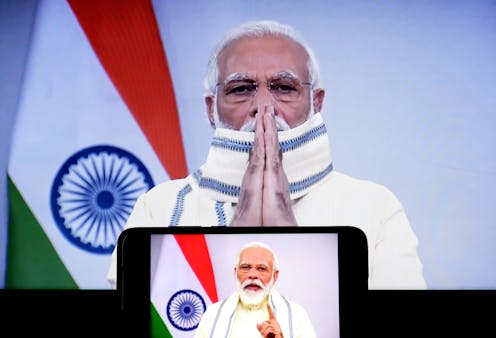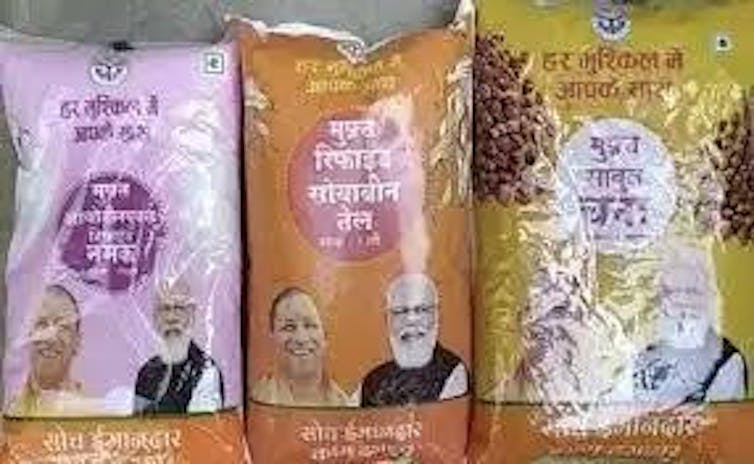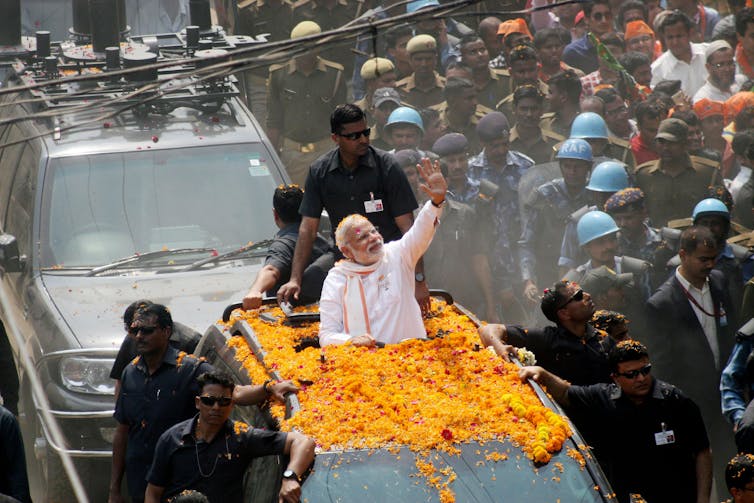
India’s ruling Bharatiya Janata Party (BJP) has unexpectedly retained power in the politically crucial state election in Uttar Pradesh. Its win, with a reduced majority, has surprised those who had reported widespread anger against the party and its candidates.
India’s fourth biggest state Uttar Pradesh is significant because of its symbolic connection with Prime Minister Narendra Modi’s plans to create a constitutionally Hindu state in which Hindus would have more rights than other citizens and where religious minorities would have reduced rights and autonomy: the Hindutva project.
This state, with its 80 parliamentary seats (more than one seventh of the 543 total) is where a campaign by Hindu extremists to demolish the medieval Babri mosque and to replace it with a temple was waged over three decades. The illegal demolition of the mosque led to weeks of clashes between Muslims and Hindus, and fed into the BJP’s national rise.
This win in Uttar Pradesh, following the BJP’s victories in three smaller states, has serious implications for any pushback against Modi’s agenda.
Election rallies by BJP leaders (including some of Prime Minister Modi’s) were small compared to those of by opposition figures, and large protests by young people against the government’s poor record on jobs, gave hope to Modi’s critics of an end to the BJP’s rule in the state.
A win by the BJP had also looked unlikely because Yogi Adityanath, the states’s chief minister, had presided over a shambolic COVID response, with corpses floating down the holy Ganga river or buried on its banks.
Opposition predicted
Western parts of the state had been a stronghold of the farmers’ movement that had forced Modi to withdraw his three bills for radical transform of agriculture, with government price support to farmers replaced by market forces.
While the BJP’s performance on some issues was poor, a number of measures may have convinced voters that Modi personally was invested in their wellbeing. The COVID vaccination programme credited Modi personally for the vaccine, holding a record-breaking vaccination drive on his birthday, putting up hoardings showing ordinary people thanking him for the vaccine, and COVID certificates carried his photographs.
During the pandemic, there was emergency distribution of packets of salt, cooking oil, chickpeas, all carrying photographs of Modi and Yogi (see photograph below). Small sums of cash in envelopes bearing the party logo have also been distributed to UP’s poor.

Though government data shows this is a state with high levels of violent crime, the popular belief that Yogi has a good record on law and order suggests a success of a long-term Hindutva strategy to associate Muslims with criminality. This has included use the word “jihad” when describing inter-religious marriages, land disputes and religion-specific clothing to create perceptions of Hindus under threat.
Bulldozers, used to demolish many Muslim homes, were sometimes actually parked in campaign rallies where more bulldozing was promised. The fact that Muslims were core supporters of the main opposition Samajwadi Party became the basis for the BJP to associate the party itself with criminality. Many BJP candidates made openly Islamophobic speeches which seem to have gone under the radar of the Election Commission.

The UP election shows that the long-awaited revival of the Congress Party has still not happened. The Congress Party was led by Mahatma Gandhi and later Jawaharlal Nehru, India’s first prime minister. Both strongly supported the idea of India as a secular state. By all accounts, party leader Priyanka Gandhi ran a spirited campaign. Her rallies attracted large crowds, and she explicitly made appeals to women across castes and classes, and distributed 40% of party tickets to them. But the party’s moribund local organisation and lack of deep roots reflected in the results.
But, although opposition candidates prevailed in some strongholds of the anti-farm laws movement, the BJP won all six seats in Lakhimpur Kheri, where a car carrying the son of Modi’s minister of state for home affairs ran over and killed three protesting farmers. With few exceptions, the farmers’ movement’s energy did not dent the BJP enough to defeat it.
Read more: India farmers' protests: internet shutdown highlights Modi's record of stifling digital dissent
The BJP has used social and other media as part of its state-level electoral strategy. BJP affiliates created controversy in Karnataka state by barring entry of hijab-wearing Muslim girls to schools and colleges, on the grounds that such religious attire was not permitted. These incidents were carried by India’s frenzied television channels for days.
Modi’s image control
During the Ukraine conflict some Indian media coverage created the impression that Putin, Zelenskyy and Biden were waiting for Modi to resolve the conflict. There were also false reports that Modi had got Putin to stop offensive actions for six hours to enable Indian students to evacuate, which played endlessly on television. Meanwhile photographs and videos of Modi are strictly controlled to protect his image, creating a veritable “photocracy”.
BJP’s win in Uttar Pradesh signals the deepening of a popular authoritarianism. It allows Modi to push on with his project of moving forward with legal changes to the constitution. But not everywhere is like Uttar Pradesh, the heartland of Hindutva politics and the BJP’s most prized jewel. It remains to be seen if the same strategies work in other states.
Subir Sinha does not work for, consult, own shares in or receive funding from any company or organization that would benefit from this article, and has disclosed no relevant affiliations beyond their academic appointment.
This article was originally published on The Conversation. Read the original article.







